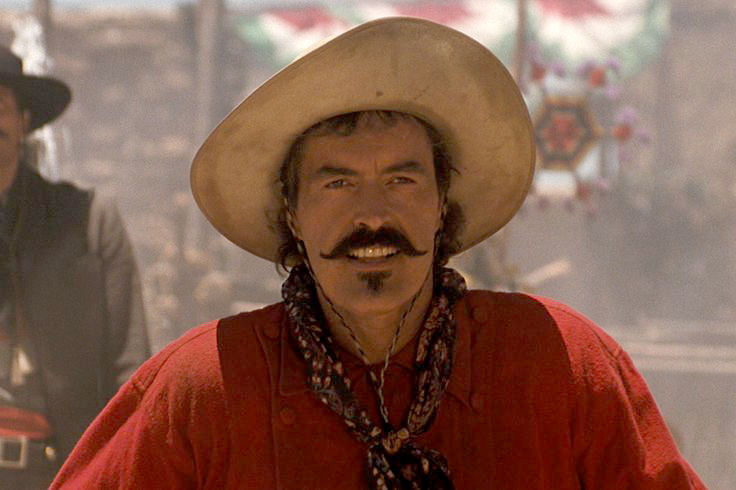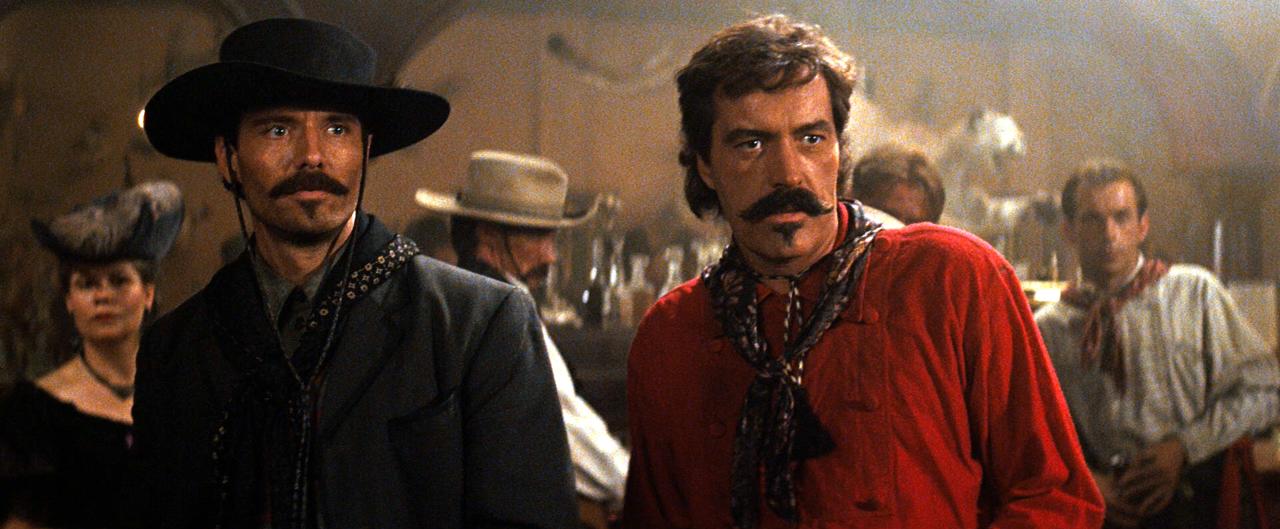William Curly Bill Brocius or Brocious (c. 1845-March 24, 1882) was an American Old West outlaw, gunman and member of the Cow-boys outlaw gang of the Tombstone area in the Arizona Territory during the early 1880s.Brocius is sometimes confused with Curly Bill Graham, who was a different outlaw of the same general place and period. In newspapers of the time Brocius is usually known simply as Curly Bill , but later he was also referred to by the spelling of Curley Bill . The spelling of Brocious has also been used. but Brocius is the name the outlaw used for his maildrop in the Arizona Territory, according to one published letter of the time. Brocius is probably an alias. His birth name (including middle initial) and date of birth are unknown.Stories that Brocius once had a wife and children and paid another man to fight in the American Civil War for him, all arise from unverifiable claims in a letter that somebody (later untraceable) once sent to historian Ben Traywick. Brocius probably came to the Arizona Territory from Texas around 1878 after arriving at the San Carlos Reservation with a herd of cattle, but his earlier history is a matter of question. Wyatt Earp, from conversations with Brocius while transporting him to Tucson for trial (for shooting town Marshal Fred White) in 1880, thought Brocius was an escaped outlaw from El Paso, Texas. There, he is the man who possibly had his right ear shot through by Texas Ranger Thomas Mode. [1]These conversations with Earp were reported in the Tombstone Epitaph at the time. According to Earp, Curly Bill had asked him about lawyers during the journey, and Earp had recommended a man named Zabriski. Curly Bill had said he could not use Zabriski because Zabriski had years earlier been his state prosecutor for a crime he had been convicted of in El Paso, Texasa robbery in which a man had been killed. Later historical work based in this fact has linked Brocius with a man known as William Curly Bill Bresnaham, who was convicted in a Texas robbery attempt in 1878 with another known Cow-boy of the Tombstone area, named Robert Martin. These men were convicted and sentenced to 5 years in prison, but both escaped, presumably to the southwest Arizona Territory. Since both Robert Martin and Curly Bill became known as leaders of the rustlers in Arizona Territory, they are likely the same Robert Martin and Curly Bill of the Texas crime. According to historian Robert M. Utley, Robert Martin was a member of the Jesse Evans gang of outlaws in New Mexico during the mid to late 1870s. Billy the Kid briefly joined this group before going to work for John Tunstall. Evans' gang, a loosely-knit consortium of desperadoes known as The Boys , would end up fighting against the Regulators during the Lincoln County War. Because of the time frame, location, and his friendship with Martin, Curly Bill Brocius may have been a member of the Evans gang as well. When Brocius was shot in Galeyville in 1881, he derided his attacker, Jim Wallace, as a Lincoln County sonofabitch . It is along that time he is believed to have first met Pony Diehl, who would later be a suspect in many of the crimes committed by the Cowboy faction.Undersheriff Wyatt Earp (with a deputy) was transporting Brocius to Tucson for trial after the October 27, 1880, shooting of Tombstone town Marshal Fred White, following an incident where Brocius' gun discharged (apparently accidentally) while he was drunk and surrendering it to White. Initial reports indicated Brocius might have employed the commonly used road agent's spin on White, but Wyatt's testimony later largely discounted this theory. He was arrested immediately after the incident by Wyatt Earp, who buffaloed (pistol whipped) him in the process, knocking him briefly unconscious. While Brocious reportedly regretted shooting White, he did not consider himself to have committed a crime (even directly after the act, by his own testimony), and deeply resented the pistol-whipping as an unnecessary and humiliating response from a man he barely knew and respected not at all. Earp, acting in his capacity as deputy sheriff (undersheriff for the Tombstone area) of Pima County, Arizona, then took Brocius to Tucson the next day for trial, possibly averting a lynching. Brocius waived his right to a preliminary hearing, which is evidence he wanted to get out of town.White died two days after being shot, by which time Brocius was in jail in Tucson. Although formally charged with the murder of White, and spending most of November and December 1880 in jail awaiting trial, Brocius was acquitted with a verdict of accidental death. Before dying, White testified that he thought the pistol had gone off by accident, and that he did not believe the shooting was intentional. Wyatt Earp also testified in favor of Brociusan irony, given their later deadly feud. Brocius was known as a rustler, but for a time, he also worked as a tax collection agent for Cochise County Sheriff Johnny Behan, making other rustlers pay taxes on their stolen cattle (the money went into the sheriff's coffers and added to his salary).On May 26, 1881, Brocius was shot by a compadre after an argument in Galeyville. The bullet passed though his neck and out the opposite cheek, and he survived.In July 1881, Brocius and Johnny Ringo were said to have gone to Hauchita, New Mexico, to kill William and Isaac Haslett in revenge for the deaths of Clanton members Bill Leonard and Harry Head, who had attempted to rob the Haslett brothers' general store weeks earlier. Later in July, Brocius was said to have led an ambush attacking a Mexican trail herd in the San Luis Pass killing six vaqueros and torturing the remaining eight men. There is no way of historically verifying these stories however, and Brocius was not charged with the crimes. These events, like the Haslett killings, also occurred quite near the time of Brocius' very serious wound, so his involvement in them is somewhat questionable. Diarist George Parsons saw Brocius on October 6 at the ranch of the McLaury brothers in the Sulphur Spring Valley, while Parsons was riding as part of an Indian scouting party, and noted that even by then, Curly Bill was well enough to ride but had not yet completely recovered from his wound of 5 months before.Following the death of Old Man Clanton in the Guadalupe Canyon Massacre on August 13, 1881, Brocius became a primary leader in the very loose-knit Cowboy gang. Parsons refers to Brocius as Arizona's most famous outlaw in early October 1881. However, despite many reports since, the Cow-boy gang was not closely organized. They had a loose gang-based association but broke off into several small groups, and outlaw acts committed by them were rarely well planned or coordinated. The gang was a collection of independent outlaws that used their association with the Cow-boys as a base of operations.Following the Gunfight at the O.K. Corral in October 1881, Brocius may have participated in an attempt to kill Virgil Earp and the assassination of Morgan Earp. Brocius was not charged since there were no eyewitnesses to either crime.After the killing of Frank Stilwell by the Earp party in Tucson on March 20, 1882, during the Earp vendetta ride, Brocius was deputized, given a warrant issued for Wyatt Earp by Sheriff Johnny Behan, and sent to bring back Earp, who was in the Whetstone Mountains outside town.Earp, who was also looking for Brocius in revenge for the death of his brother Morgan, encountered Curly Bill on March 24, 1882, at Iron Springs (present day Mescal Springs). Brocius was camping outside his tent near the springs and was surprised while in the act of cooking over a campfire. In the gunfight that followed, Wyatt killed Brocius with a double shotgun blast to the chest from a range of about 50 feet (15 m). Brocius narrowly missed his own shot, hitting only Wyatt's long duster coat.After Brocius' death, his friends were said by John Flood to have buried the body on the nearby Frank Patterson ranch on the Babocomari River. This land, close to the original McLaury ranch site before the McLaurys moved to the Sulphur Springs Valley in late 1880, originally is believed to have previously belonged to Frank Stilwell and is located on the river about five miles (8 km) west of the ghost-town Fairbank. If Brocius' body is there, in a still-wild section of country, the gravesite has been lost. Some claimed that Curly Bill escaped, changed his name, and went to Texas. However, he was never seen again in Tombstone after March 24, 1882, despite a $2,000 reward later put up by the Tombstone Epitaph for an authentic interview and sighting of him alive.Tombstone historian Ben Traywick has argued that this was too much money for a man like Brocius to turn down, especially since he was not wanted by the law in Arizona for any crime and had no reason to disappear when he did (and certainly no reason to go back to Texas, where he probably was a wanted man). In any case, the money offered by the Tombstone Epitaph was never claimed.
Show less «




